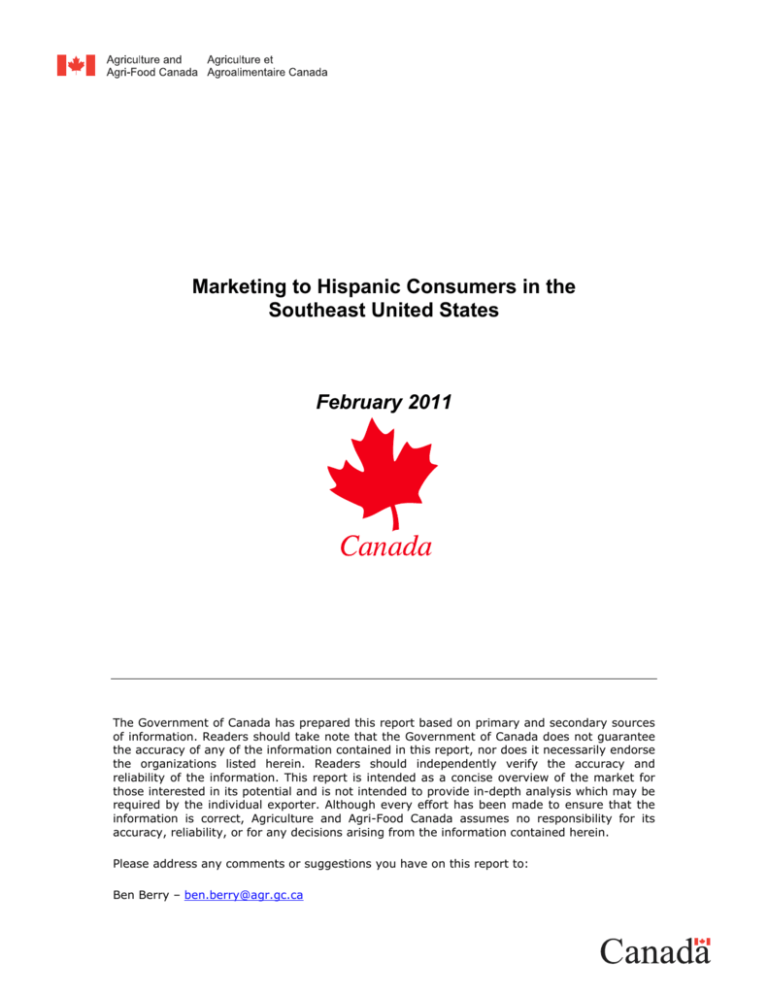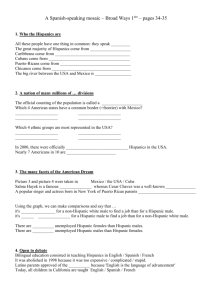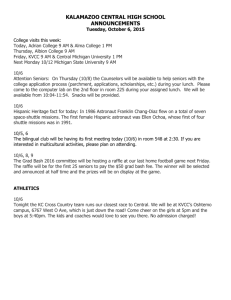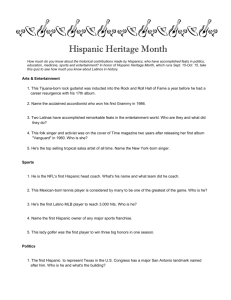PDF Version
advertisement

Marketing to Hispanic Consumers in the Southeast United States February 2011 The Government of Canada has prepared this report based on primary and secondary sources of information. Readers should take note that the Government of Canada does not guarantee the accuracy of any of the information contained in this report, nor does it necessarily endorse the organizations listed herein. Readers should independently verify the accuracy and reliability of the information. This report is intended as a concise overview of the market for those interested in its potential and is not intended to provide in-depth analysis which may be required by the individual exporter. Although every effort has been made to ensure that the information is correct, Agriculture and Agri-Food Canada assumes no responsibility for its accuracy, reliability, or for any decisions arising from the information contained herein. Please address any comments or suggestions you have on this report to: Ben Berry – ben.berry@agr.gc.ca Table of Contents Overview ...................................................................................................... 2 Demographics ............................................................................................... 2 Population ................................................................................................. 2 Households ................................................................................................ 2 Consumer Profile ........................................................................................... 3 Foreign Born Hispanics ................................................................................ 4 Second or Third Generation American Born Hispanics....................................... 4 Bi-Cultural Hispanics ................................................................................... 5 Eating Habits ............................................................................................. 5 National Retail Trends..................................................................................... 6 Retail Trends in the Southeast Market ............................................................... 7 Leading Retailers in the Southeast Market ...................................................... 8 Opportunities for Canadian Agri-Food Exporters.................................................. 9 Key Resources ..............................................................................................10 Marketing to Hispanic Consumers in the Southeast United States: February 2011 1 Overview Hispanics are the largest and fastest growing ethnic minority in the United States (U.S.). It is estimated that by 2012, Hispanics will account for nearly one out of five Americans; reaching 50 million. As the Hispanic population grows, the demand for ethnic foods, even among non-Hispanics, grows at a total of 5% per year. Hispanic consumers spend more on groceries, make more frequent shopping trips, prefer bulk over smaller packaged foods, and eat at home more often than the average American. Additionally, Hispanics typically demand fresh ingredients for their food. These characteristics of this consumer segment offer a variety of significant opportunities to Canadian agri-food exporters. The Hispanic population in the Southeastern states (Florida, Georgia, Tennessee, Alabama, Mississippi, North and South Carolina) is incredibly diverse. The majority of Hispanics in most of the Southeastern states are Mexican, with the exception of Florida where there is a large influx of Hispanics of Cuban heritage. The purpose of this report is to inform Canadian agri-food exporters of the diversity and complexity of Hispanic consumers in this region, and to help highlight areas where Canadian exporters can take advantage of this lucrative and fast-growing market. It is important to note that from a marketing perspective, the U.S. Hispanic community should not be viewed as a homogeneous group. Demographics Population Hispanics represent the fastest growing demographic in the U.S. today. In 1970, the Hispanic population in the U.S. was 9.6 million, or 4.7% of the total population. This population has now soared to over 45 million, or 15%. The Hispanic or Latino consumer market is broken down into persons originating or descending from Mexico, Puerto Rico, Cuba, South America, Central America or other Spanish speaking countries and cultures. The Hispanic group is termed as an ethnic group by the U.S. Census Bureau that contains different cultures and races, brought together by the single Spanish language. Of Hispanics, 91% under the age of 18, and 47% of Hispanic adults were born in the U.S., respectively. Hispanics are, on average, younger than the average American consumer. The Hispanic population is largely concentrated in the Southwest and Pacific Southwest regions, as well as Florida. Key Hispanic communities also exist across the U.S. Hispanics are the majority population in 20 U.S. states, and represent a sizable portion of many of America’s largest cities. Households Hispanic households have an average of 3.34 residents, whereas the national average is 2.57. More than 43% of Hispanic households have over three individuals residing in them, as opposed to the national proportion of 22%. Marketing to Hispanic Consumers in the Southeast United States: February 2011 2 Consumer Profile For Hispanics, food is often at the centre of family gatherings and celebrations. Cooking traditional, cultural meals is an important aspect of family life for Hispanics. Due to this strong sense of family and community that is an essential aspect of food preparation, Hispanics don’t typically eat out very often. Instead, they cook dinner at home approximately 5.6 times a week. Additionally, Hispanics spend $39 more a week on groceries than the average American. Hispanics also spend 49% more a year on produce than their non-Hispanic counterparts. Supermarkets are the primary outlet through which Hispanics purchase groceries, although they also dedicate over 30% of their food budget to purchasing products from non-supermarket stores; comparatively, the average American shopper only spends 18% of their food budget at non-supermarket stores. Examples of nonsupermarket stores that Hispanics shop at include butcher shops, bodegas, drug stores, bakeries, convenience stores, and other specialty shops. Ultimately, Hispanic consumer trends and food preferences are dependent on the level of each consumer’s acculturation. Newly arrived Hispanics will often shop at small, speciality stores, while Hispanics who have been in the country for longer are more likely to shop at retail chains and supermarkets. According to a study that was co-sponsored by New American Dimensions, the Food Marketing Institute, and ADVO, loyalty to a store is more common amongst Hispanics who are less acculturated. These consumers will often shop at a specialty store that offers their services in Spanish, and contains bilingual products, as this is a more comfortable environment for them as opposed to an impersonal retail chain. The total Hispanic population of the Southeastern states include: Florida (19% of the state’s population) Georgia (8.3% of the state’s population) North Carolina (7% of the state’s population) Tennessee (4.2% of the state’s population) South Carolina (4% of the state’s population) Alabama (3.2% of the state’s population) Mississippi (2.5% of the state’s population) Despite its lower representation of Hispanics, Georgia has the highest population growth rate of Hispanics in the country at 59.4%. This is closely followed by South Carolina (57.4%) and Tennessee (55.5%). The Hispanic population in the Southeastern U.S. is significant, with Florida holding the third largest population of Hispanics by state. Additionally, the Hispanic population in this region of the country is growing at a considerably higher rate than the rest of the country. As of 2008, Hispanics in the Southeastern United States are represented by the following backgrounds as follows: Caribbean – 2.25 million (4% of the region’s population) Mexican - 1.9 million (3% of the region’s population) South American – 787,000 (1% of the region’s population) Central American – 710,000 (1% of the region’s population) Other Hispanic – 252,000 (0.45% of the region’s population) Marketing to Hispanic Consumers in the Southeast United States: February 2011 3 Foreign Born Hispanics In a three-year estimate, from 2005-2007, by the U.S. Census Bureau, between 4050% of Hispanics were foreign born, less acculturated, and spoke Spanish primarily at home. In general, Hispanics make more shopping trips, spend more on groceries, and eat more at home than their mainstream American counterparts. This is also due in part to Hispanic families being larger than the national household average; Hispanic households have an average 3.34 residents, while that of the general American population is 2.57 persons. Foreign born and some bi-cultural Hispanics are more likely to visit independent bakeries, butcher shops, produce markets, bodegas (i.e. small markets), convenience stores, drug stores, and warehouse clubs than other shoppers. In fact, over 50% of all three Hispanics segments visit such stores where they spend about 30% of their total food dollars. Mainstream American shoppers (and potentially more acculturated Hispanics), in comparison, spend roughly 18% of their grocery budget at these formats. Fresh, quality products are especially important to foreign born Hispanics and are frequently used in cooking. Since these Hispanic consumers generally prefer to prepare and serve food at home, the average number of meals eaten at foodservice outlets is low at only 1.2 times per week. Second or Third Generation American Born Hispanics This segment consists of the most acculturated Hispanics that are usually second or third-generation born Hispanics. Second and third-generation Hispanics tend to speak primarily English, while Hispanics that are first-generation born tend to be bicultural and bilingual. American born Hispanics, especially second and third-generation born, mostly follow the consumption patterns of the general American market. Although many foreign born and less acculturated Hispanics often cook meals at home, more acculturated Hispanics are becoming increasingly more westernized, and therefore the demand for convenience food is growing. Double-income Hispanic families are leading much of the growth in the frozen and refrigerated grab-and-go product category. Despite the increasing demand for ready made products, American born Hispanics are increasingly demanding healthier products and limiting consumption of sugar, salt, fried foods, and cheese. Acculturated Hispanics are more likely to shop at Americanized stores such as larger warehouse club stores, citing their convenience and efficiency as reasons for their choice. This is a stark difference between foreign born Hispanics, who generally shop at smaller independent "local" type stores. Most American born, or foreign born Hispanics that have been living in the U.S. for quite some time, only visit supermarkets 5.1 times per month. This is a substantial difference from the average 26 shopping trips per month by other Hispanics. American born Hispanics generally have a higher household income than other Hispanics, yet they still tend to look for bargain products. Although cheaper products are sought, American born Hispanics still look for high-quality goods. Products that are typically bought are usually more mainstream American. They are generally more brand aware and purchase more U.S. brands than their foreign born counterparts. Marketing to Hispanic Consumers in the Southeast United States: February 2011 4 Bi-Cultural Hispanics This Hispanic group is difficult to define as it is not necessarily a midpoint between the most and least acculturated Hispanics. Generally Hispanics that are bi-cultural are either first-generation American born or foreign born, but have been living in the U.S. for an extended period of time. These consumers comprise 53% of the Hispanic ethnic group and are generally bilingual and respond to both Spanish and English advertisements. Some reports define bi-cultural Hispanics as those who strongly identify with their country of origin while still adopting the norms and consumption patterns of mainstream Americans. When trying to quantify consumer preferences for food and beverages, it is important to note that rural and urban bi-cultural Hispanics differ from each other. Rural bi-cultural Hispanics tend to have food consumption patterns close to less acculturated Hispanics, while urban bi-cultural Hispanics tend to have patterns of the more acculturated Hispanic segment. When it comes to watching Spanish television on the other hand, more urban bi-cultural Hispanics watch Spanish networks than rural bi-cultural Hispanics. As well, bi-cultural Hispanics are about as educated, or less educated, as foreign born Hispanics, with only 1/3 receiving a high school degree and 22% leaving school before the eighth grade. Urban bi-cultural Hispanics are increasingly demanding authentic Mexican convenience goods and fast food. In fact, Mexican two food entrées accounted for the largest ethnic frozen food sales increase in American supermarkets between 2005 and 2006. Bi-cultural Hispanics will shop at large Americanized supermarkets with many also shopping at smaller markets, especially if they were brought up doing so. Bi-cultural Hispanics are very brand aware and loyal, but still look for a bargain. Eating Habits Most Hispanics maintain elements of the traditional diets of their country of origin. This diet often includes various grains, beans, and fresh fruits and vegetables. Preparing and eating meals is a family/community affair, thus most meals occur in the home. The United States Department of Agriculture (USDA) conducted studies that determined numerous facts regarding the most common foods that Hispanics consume. o Hispanics eat more rice than the average American, but less pasta and cereals. o Hispanics eat fewer vegetables than typical Americans, with the exception of tomatoes, though they consume more fresh fruits. o Beef, eggs and legumes are staples of the Hispanic diet, but processed meats such as sausage, luncheon meats, and hot dogs are not a common feature. o Hispanics are less likely to consume a high degree of fats, oils, sugars, or candy. o Vitamin E, calcium and zinc intake amongst Hispanics is generally below the recommended daily dose. The USDA warned that the Hispanic food market is not static, and is constantly changing and evolving. A key finding by the USDA concluded that Hispanic cuisine differs based on region, town, and family. Marketing to Hispanic Consumers in the Southeast United States: February 2011 5 Regional variations can include a difference in spiciness, pungency, sweetness, and heat, which makes it difficult to define exactly what an “authentic” Hispanic meal is. Below is an example that the USDA uses to differentiate some of the variances in flavour of a sofrito, which is the cooking sauce that is used to flavour rice, fish, beans, and stews: o The Cuban version of sofrito is prepared using parsley and is quite mild. o The Spanish version is made with tomatoes and has a sweeter taste. o The Puerto Rica sofrito contains cilantro and is pungent. The preparation of certain foods can vary based upon region of origin. Tortillas are an example of a food item that is prepared differently based upon country of origin. o Most Mexicans will put the corn in a lime bath in order to prepare masa harina, while for cooks from regions of Mexico where wheat is more abundant than corn, a flour tortilla is prepared. o Venezuelans, on the other hand, pre-cook the corn in a process to yield harina pan, which gives the tortilla a different kind of texture. Additionally, different Hispanic segments prefer some foods over others. o Caribbean and Latin Americans enjoy rice, while Mexicans like corn and amaranth, and South Americans favour potatoes, quinoa, and wheat. Beans are a common element of the Hispanic diet in the U.S., as Hispanics of Mexican descent, who account for the second largest segment of the Hispanic population in the Southeastern U.S., consume 34 pounds per capita of dry beans; non-Hispanic Americans eat only about six pounds per capita. National Retail Trends Hispanics include a wide variety of consumers that vary largely depending on country of origin and level of acculturation. Hispanics most comfortable shopping in a mainstream setting are often more acculturated, while Hispanics who are less acculturated prefer shopping at a store that has Spanish speaking employees and signage, as well as bilingual packaging and more Hispanic-oriented products. Store loyalty is highest amongst less acculturated Hispanic consumers. This poses a formidable challenge to American retailers, who must either offer a Hispanic format of their stores in order to provide a comfortable shopping experience to this segment of Hispanic consumers, or must prove that an impersonal, big box type supermarket best serves their shopping needs. The incredible price sensitivity of Hispanic consumers leads many of them to shop at stores that are notorious for low pricing. This trend has made it difficult for some U.S. retail chains to break into this market. Tortillas are the most popular Hispanic product in general. Sales reached US$1 billion in 2006. Sales of salsas and sauces were a close second at US$945 million. Other popular Hispanic foods include avocadoes, fajitas, hot peppers, chicken, beans, rice, cheese, corn, potatoes, and guacamole. Ethnic seasonings are also characteristic of the Hispanic consumer group in general, with 91% of Hispanics using fresh and dried spices, seasonings, and sauce mixes on a regular basis. Brand names with high recognition and popularity among the Hispanic community include Bimbo, Bustelo, Coca-Cola, Dona Maria, Faraon, Goya, Guerror, Herdex, Iberia, Juanitas, Knorr, La Cena, La Constena, Maseca, Nestle, Pilon, Productos Maya, and Tampico. Marketing to Hispanic Consumers in the Southeast United States: February 2011 6 Advertising to Hispanics is, again, very dependent on level of acculturation. More acculturated individuals receive the bulk of their advertising in English; while the less acculturated receive most in Spanish. When advertising in Spanish it is important to note variations in dialect that are dependent upon an individual’s area of origin. Retailers will often consult advertising agencies to determine which dialect to use; this is often determined by examining which segment of Hispanics comprises the bulk of the population. The approach that generates the highest level of ad recall though, occurs when the advertisements are bilingual. A popularized term for the integration of English and Spanish is “Spanglish”. Regardless of whether the message is stated in Spanish or English, the quintessential element in communicating with a Hispanic audience is a strong emphasis on family situations and values. American retail chains are exploring a diverse range of options on how to target Hispanic consumers. Examples of numerous initiatives launched by American chains include: Beringer Vineyards launched a campaign that crossed over numerous formats, including sampling at grocery stores and Hispanic events and Spanish television commercials. The core element of the campaign was to demonstrate how well Beringer wines complimented various Hispanic cuisines. Coca-Cola has long attempted to attract Hispanic mothers by pairing its products with various meal occasions. In 2010, however, Coca-Cola took a new direction by pairing its products with home entertainment situations. Telenovelas are incredibly popular with Hispanic mothers, which is why CocaCola recruited two popular Telenovela stars to act as spokespeople for their products. The campaign included in-store displays as well as a digital platform. Within two months retail outlets that contained displays had reported a 22% increase in sales of Coca-Cola products. KeHE Distributor, a major U.S. distributor of specialty foods, delivers Hispanic food items to consumers throughout 50 U.S. states, in addition to Canada, the Caribbean, and Mexico. Some of KeHE’s brands that target Hispanic consumers include: La Comadre; La Feria del Sabor; La Casona; Miramonte. Hispanic mothers are a target of another major food industry player, General Mills. General Mills teamed up with a direct-mail magazine and launched an initiative entitled “Que Rica Vida”. The advertisements attempted to draw a connection between General Mills’ traditional American branded products and Hispanic family lifestyles. Frito-Lay, a subsidiary of PepsiCo, launched a range of spicy snacks that are exclusively aimed toward Hispanics. Frito-Lay teamed with Mexican company Sabritas, another PepsiCo subsidiary, and chose four brands that were familiar to Mexican-American consumers, which included lime and chilli corn strips and tomato and chilli chips. Additionally, new flavours of Rancheros and Doritos were developed that are geared toward Hispanic taste preferences. Retail Trends in the Southeast Market The following are various examples of American retailers in the Southeast, and their marketing efforts to draw a larger number of Hispanic customers. Publix grocery in Norcross, Georgia, aimed to accommodate Hispanic-Mexican consumers in the area. Publix, which now carries various products, used in Mexican cuisines, such as chillies, chorizo, queso fresco and corn husks, Marketing to Hispanic Consumers in the Southeast United States: February 2011 7 attempted to draw consumers away from having to shop exclusively at specialty shops in order to acquire these goods. Food Lion, a supermarket chain in North Carolina, initiated a pilot program in five stores in Raleigh-Durham, aimed at marketing to Hispanics in the area. Due to the high loyalty that Hispanic consumers have to a store, Food Lion opted to reward its Hispanic customers with phone cards and PIN numbers when they reached a certain amount of points, which are accumulated by making purchases. Food Lion converted 59 of its 1,200 supermarkets into Hispanic-oriented stores. Bush’s Beans is a popular product through the Southeast and Western states. In an effort to court Hispanic consumers, Bush’s Beans partnered with Major League Soccer teams in Chicago and Los Angeles; the popularity of soccer in the U.S. in recent years has been partially attributed to the influx of Hispanics. Winn-Dixie, based out of Jacksonville, Florida, is in the process of converting a number of its stores that are located in heavily Hispanic neighbourhoods into a strictly Hispanic layout. The store expanded the number of perishables departments and added a Latino-influenced colour scheme, in addition to bilingual signage. Winn-Dixie’s efforts are concentrated on gaining the attention of primarily Cuban-Hispanics, as they are the predominant Hispanic population in Florida. The store’s cafeteria has Cuban coffee, and a number of other Hispanic-oriented food products. The supermarket stocks a number of Hispanic specialty items including manzanos, plantains, sour oranges, malanga, and a variety of other products. Supermarket News magazine named three independent grocers in the Southeast market in their list of the Top 50 Small Chains and Independents. These included: Fresh Market of North Carolina (#14), Sedano’s of Florida (#29), and All-American Quality Foods of Georgia (#41). Sedano’s specifically caters to Hispanics, having been founded by a Cuban-American in 1962. Sedano’s has since risen to become the number one Hispanic retailer in the U.S. today; the chain currently has 30 stores throughout South Florida. Leading Retailers in the Southeast Market Hispanics historically have shopped exclusively at independent grocers, as these stores were generally the only sources of Hispanic speciality foods. However, this is no longer the case, as mentioned earlier. The table below contains information on the top three agri-food retail chains in each individual state, as of early 2009. The information includes how many stores are in operation in the state and the percentage of the market that each retailer holds. Florida - Chains Publix Walmart Superctr. Winn-Dixie # of Stores 680 159 357 % of Market 40.23 23.96 13.42 Georgia - Chains Walmart Superctr. Kroger Publix # of Stores 125 174 175 % of Market 32.23 23.21 16.37 Marketing to Hispanic Consumers in the Southeast United States: February 2011 8 Alabama - Chains Walmart Superctr. Winn-Dixie Bruno’s # of Stores 88 73 57 % of Market 46.54 11.95 7.24 Mississippi - Chains Walmart Superctr. Kroger Winn-Dixie # of Stores 59 31 16 % of Market 55.56 11.89 4.65 Tennessee - Chains Walmart Superctr. Kroger K-VA-T # of Stores 103 120 61 % of Market 39.29 24.86 7.30 North Carolina - Chains Walmart Superctr. Food Lion Harris Teeter # of Stores 104 499 127 % of Market 30.76 26.54 14.65 South Carolina - Chains Walmart Superctr. Bi-Lo Food Lion # of Stores 61 130 144 % of Market 35.10 17.61 13.19 While these major chains continue to dominate the market, it is important to note that independent grocers still play a prominent role in supplying to Hispanic consumers. Most of these independent shops contain the words Tienda Hispana (Hispanic Store) or Tienda Mexicana (Mexican Store) in their names. Opportunities for Canadian Agri-Food Exporters The fast pace at which the Hispanic population is growing in the U.S. provides an incredible opportunity for Canadian agri-food exporters. Hispanic consumer spending on food and beverages increased 18% between 2005 and 2008, compared to the 2.4% increase amongst non-Hispanic consumers. As Hispanics become more acculturated, they will develop a stronger taste for traditional American and Canadian cuisine. Secondly, the different style of ingredients and meals that Hispanics enjoy has not yet been fully met by the American market, which presents a significant opportunity for Canadian agri-food exporters to gain the attention of these consumers before other competition. Being the first to attract Hispanic consumers to a particular product is essential, as Hispanics are intensely loyal to brand labels. Some of the opportunities that exist for Canadian agri-food exporters are listed below: Wine consumption is rapidly growing amongst the Hispanic community. Since 2005, Hispanic wine consumption has increased by over 35%; this figure is still quite low compared to non-Hispanic consumers. Frozen meals have grown in popularity, increasing sales by 30% between 2005 and 2008. The number of young professionals within the Hispanic community has been the reason behind the sharp increase in these products. Fish/seafood products sales grew 10.2% in 2009. Marketing to Hispanic Consumers in the Southeast United States: February 2011 9 Candy sales grew by 8.2% in 2009, primarily due to the large influx of children in the Hispanic community. Beans and pulses are a staple of Hispanic cooking, especially MexicanHispanics. The steady growth of this demographic in the Southeast presents a growing market trend that will likely see an increase of this product over time. Canada exporters should note that for marketing purposes, most Hispanics identify themselves by their country of origin, as opposed to being referred to as “Hispanic” or “Latino”. Developing quality authentic goods using high-value Canadian ingredients that expressly address the preferences of under-represented groups is an enormous opportunity for Canadian agri-food exporters. It is vital to understand the makeup of the Southeastern Hispanic market in order for a successful business relationship to develop between Canadian agri-food exporters and Hispanic consumers in this region. Key Resources Associated Press. “Hispanic foods moving out of the ethnic aisle.” MSNBC. N.p., 14 June 2009. Web. 9 Nov. 2010. http://www.msnbc.msn.com. Belanger, Mehgan, and Don Longo. “Hispanic Lessons: Retailers and marketers shared insights on serving the needs of the growing Latino market.” Progressive Grocer Oct. 2009: 130-132. Print. “Consumer Lifestyles in the U.S - People.” Euromonitor. N.p., n.d. Web. 9 Nov. 2010. http://www.portal.euromonitor.com. Cuellar, Sandra. “The Hispanic Market in the U.S. - Opportunities and Challenges for the Food Industry.” Cornell University. N.p., July 2006. Web. 12 Nov. 2010. http://marketingpwt.aem.cornell.edu/SmartMarketing/pdfs/cuellar7-06.pdf. Dowdell, Stephen. “Good-Neighbor Policy: Winn-Dixie’s Hispanic format relies on store-level execution to meet the needs of a uniquely diverse Latino market base.” Progressive Grocer Apr. 2009: 26-30. Print. “Frito-Lay targets Hispanic community with new range.” Datamonitor Industry Reports. N.p., 23 May 2002. Web. 9 Nov. 2010. http://www.datamonitor.com. Marketing to Hispanic Consumers in the Southeast United States: February 2011 10 “The growing US Hispanic population presents a wealth of opportunities for the CPG industry.” Datamonitor Industry Reports. N.p., 23 Sept. 2010. Web. 9 Nov. 2010. http://www.datamonitor.com. Heise, Dorothy. “Hispanic American Influence on the U.S. Food Industry.” United States Department of Agriculture. N.p., Sept. 2002. Web. 12 Nov. 2010. http://www.nal.usda.gov/?outreach/?HFood.html. “Hispanic and Latino Diet.” diet.com. N.p., n.d. Web. 12 Nov. 2010. http://www.diet.com/g/hispanic-and-latino-diet. “Hispanic Products Feature.” The Shelby Report of the Southeast July 2010: n. pag. Print. Lisanti, Linda. “Marketing to a Multicultural Nation.” Progressive Grocer Oct. 2010: 19-22. Print. “Market Shares.” The Shelby Report of the Southeast Dec. 2008: 25-26. Print. Morse, David, and Bill Bishop. “Seeing Opportunity in Hispanic Shopper Behavior.” retailwire. N.p., 2009. Web. 9 Nov. 2010. http://www.retailwire.com/ Discussions/Sngl_Discussion.cfm/9843. “Various Reports.” U.S Census Bureau. N.p., n.d. Web. 9 Nov. 2010. http://www.census.gov/. Marketing to Hispanic Consumers in the Southeast United States: February 2011 11






